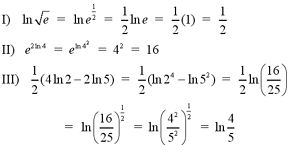|
The logarithmic function is the inverse to the
exponential function. A logarithm to the base b is the power to
which b must be raised to produce a given number. For example, log28
is equal to the power to which 2 must be raised to in order to produce
8. Clearly, 23 = 8 so log28 = 3. In general, for
b > 0 and b not equal to 1,

Some of the basic properties of logarithms are
listed below. These properties are known as the cancellation
equations, since they allow for the logarithmic expresion to be
simplified to a single variable in specific situations.
NOTE: By convention,
logarithms to the base 10 are simply referred to as log rather than log10,
since 10 is the most common base. For example, the log button on your
calculator refers to logarithms to the base 10.
Examples

Laws of Logarithms
The following laws show how to calculate
logarithms of a product, quotient or exponential expression. For any a,
x, y > 0, where a does not equal and any real number r,

Two important facts that can be useful in
logarithmic calculations are that logb1 = 0 and logbb
= 1.
Examples

Note: For a complex
example of expanding a logarithmic expression using the laws of
logarithms, see question #1 in the Additional Examples section at the
bottom of the page. For an
example of solving a logarithmic expression, see question #2 in the
Additional Examples section.
Natural Logarithms
A natural logarithm, denoted ln rather
than log, is a logarithm with base e. The irrational number e is equal
to 2.718281828459... This number has important applications in calculus
and the true meaning of it will be explained in the Derivatives of
Logarithmic Functions section. For now, it can be taken as a special
number that is approximately equal to 2.718.
The notation for natural logarithms is a bit
different than the notation for regular logarithms. The natural
logarithm is equal to the logarithm with the base e.

One special property of natural logarithms is
that ln e = 1. This property is easily seen, since the logarithmic form
of ln e is loge e, which is always equal to 1 for any
variable.
The definition of natural logarithms follows from
the definition of regular logarithms, where

The cancellation equations for natural logarithms
also follow from the property for regular logarithms.
The laws of logarithms can also be applied to
natural logarithms by letting the base a equal e. The laws of natural
logarithms are shown below. For any x,y > 0 and any real number r,

Examples

Note: For a complex
example of solving a logarithmic expression, see question #3 in the
Additional Examples section at
the bottom of the page.
Change of Base Formula
As stated earlier, calculators are only able to
calculate logarithms to the base 10 or e. The change of base formula
allows us to calculate logarithms of any base with our calculators. The
general change of base formula states

This formula can be modified to convert between
logarithms and natural logarithms.

Examples
Additional Examples
1
| Expand the logarithmic expression using the laws of logarithms
2
| Solve the logarithmic expression for x
3
| Solve the logarithmic expression for x, using the laws of logarithms
|
Top of Page |
|

